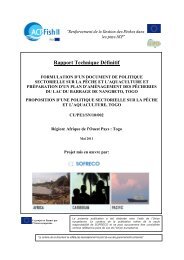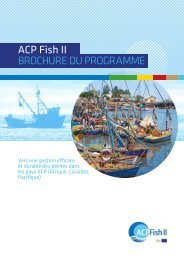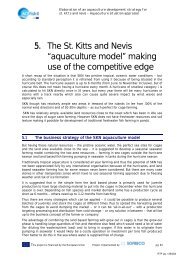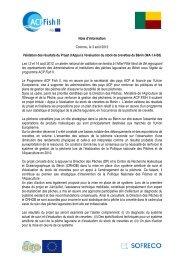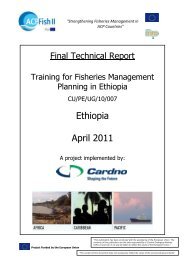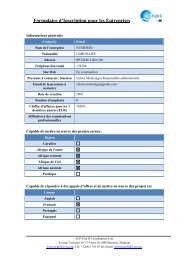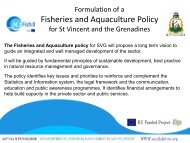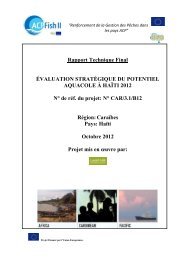Create successful ePaper yourself
Turn your PDF publications into a flip-book with our unique Google optimized e-Paper software.
1. BACKGROUND INFORMATION1.1. Beneficiary countryThe direct beneficiary country for the implementation of this contract is Namibia.1.2. Contracting Authority<strong>ACP</strong> FISH <strong>II</strong> Coordination Unit36/21 Av. de Tervuren5th FloorBrussels 1040Tel: +32 (0)2.7390060Fax: +32(0)2.73900681.3. Relevant country backgroundThe republic of Namibia, bordering Angola, Zambia, Zimbabwe, Botswana and South Africa, has atotal population of 2.2 million leaving in a territory of 825,418 Km 2 . The country has a 1,500 kmcoastline on the Atlantic Ocean and a defined Exclusive Economic Zone (EEZ) of 200 nauticalmiles. The country is classed as “medium” in human developed terms by the UNHD <strong>Report</strong> (2009),with a GPD per capita (PPP) of US$ 5,155 in 2007, but remains one of the most unequal societiesin the world and almost 30% of the population is considered ‘poor’. The economy consistsprimarily of mining (12.4% of the GDP in 2007), agriculture (9.5%), and manufacturing (15.4%).<strong>Fish</strong>ery’s average contribution to GDP has been estimated to be 6.5 % in the last years. Namibiahad a high unemployment rate, standing at 29.4% in 2008.Namibia is a presidential representative, democratic and multi-party republic since 2004 whenelections were hold and SWAPO retained the presidency, after which elections have been heldregularly. In 2005, the Anti-Corruption Commission (ACC) was established and has since receivedincreasing resources from the budget. The country is therefore considered one of the best countriesin Africa regarding human rights, and one of the most stable.The Government of Namibia embarked in a decentralization process since 1997 when the NationalAssembly unanimously adopted decentralization as a national policy for the promotion of equaleconomic, cultural and socio-economic development and improved public service provision acrossthe country. In 2008 the third National Development Plan (NDP3) was adopted. This plan ispoverty-focused and contains benchmarks consistent with the country’s Poverty ReductionStrategy (PRS) – the National Poverty Reduction Action Programme (NPRAP) of 1998. The PRSfocuses on increasing agricultural production and productivity, promoting community basedtourism, promoting the development of small and medium scale enterprises, strengthening socialsafety nets, and generating labour intensive public works.1.4. Current state of affairs in the relevant sectorNamibia’s coastline falls within the Benguela Current system, one of the most productive habitatsin the world, rich in pelagic and demersal fish. Marine fisheries are exclusively industrial and are amajor contributor to the national economy, with the potential for sustainable yields of up to 1.5million metric tons per year. The demersal fishery is the most valuable fishery in Namibia, andalmost the entire catch is exported. About 90% of the catch is hake, with monkfish making up mostof the remainder. The mid-water fishery for horse mackerel is next in importance. <strong>Final</strong>ly, there is asmaller pelagic fishery with canned sardine as the most valuable product. The value of landingswas N$3,593 in 2007 and direct revenue generated from the sector was US$16 million in 2005. Thetotal employment in the fishing industry has been estimated to be about 13,400 people in 2008, and2008 Page 2 of 1108 - B<strong>II</strong> - Terms of Reference.doc





